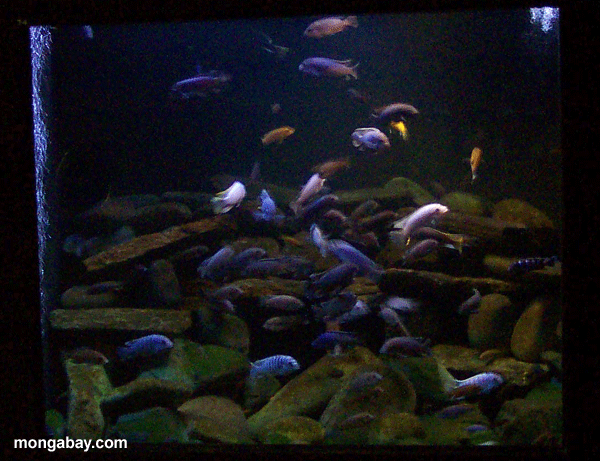 The cichlids from Lake Malawi and Lake Tanganyika in Africa are overcool, highly aggressive, hardy, easy to breed and make a superb display. They require a good under gravel filtration system, as they ar every intolerant of nitrite and soon react adversely if any waste matter disallowed to build up in the tank. These fish tend to dig into the grave land excavate down to the under gravel filter plate, unless there is gravel tidy to prevent this. Rift Lake cichlids need plenty of rocks among which to establish territories. Unfortunately, many Rift Lake cichlids are fond of nibbling vegetation and this, coupled with their digging habits, does not encourage healthy plant growth. Plastic plants are an alternative, but anchor them into the gravel with rocks to prevent them being uprooted. Keep the water in a Rift Lake cichlid tank at about 25.5°C(78°F) and make sure it is well aerated, hard and alkaline. Carry out regular water changes of 25 percent to keep the water free of any waste build-up. Most of these fish like to graze on algae on the rocks in the tank; good lighting encourages algal growth.
The cichlids from Lake Malawi and Lake Tanganyika in Africa are overcool, highly aggressive, hardy, easy to breed and make a superb display. They require a good under gravel filtration system, as they ar every intolerant of nitrite and soon react adversely if any waste matter disallowed to build up in the tank. These fish tend to dig into the grave land excavate down to the under gravel filter plate, unless there is gravel tidy to prevent this. Rift Lake cichlids need plenty of rocks among which to establish territories. Unfortunately, many Rift Lake cichlids are fond of nibbling vegetation and this, coupled with their digging habits, does not encourage healthy plant growth. Plastic plants are an alternative, but anchor them into the gravel with rocks to prevent them being uprooted. Keep the water in a Rift Lake cichlid tank at about 25.5°C(78°F) and make sure it is well aerated, hard and alkaline. Carry out regular water changes of 25 percent to keep the water free of any waste build-up. Most of these fish like to graze on algae on the rocks in the tank; good lighting encourages algal growth.Because of their aggressive behavior, it is best to keep these cichlid sonly with other Rift Lake species and certain Synodontis catfishes as scavengers. To reduce aggression, try crowding the fish together, so that particularly aggressive fish has plenty of rivals to pick on. If you buy all the fish at the same time, this will stop one fish establishing territory before the others have had a chance to settle in. Many Lake Malawi cichlids are similar in appearance, which can lead to aggression when 'like' fish are kept together in the aquarium.
Lake Tanganyika cichlids are more varied in behavior, body shape and breeding technique than those from Lake Malawi. Some largemouth, while others place their eggs on rocks and guard them even after they arc free-swimming. Apart from these differences they require similar care and maintenance.
Females of the golden cichlid (Melancholia) from Lake Malawi have rows of black, white and yellow stripes, whereas the base co lour is blue in the male. These fish are rarely more than 10cm(4in) longhand females remain smaller.They eat all the usual foods.
These cichlids are mouthbreeders usually quite easy to breed. The female lays eggs on the gravel or rock, while the male swims with heroin a tight circle. She then turns around to pick up the eggs with her mouth'.Egg spot' markings on the anal fin of the male look like eggs to the female and she tries to collect them in her mouth. In doing so, she collects mouthful of sperm instead and this fertilizes the eggs. The female keeps the eggs in her mouth until they become free-swimming fry, which can take 21-50 days. During this time, the female does not usually feed and it is advisable to remove her (with the fry)to a separate maternity tank to develop in peace. Once the fry are released from the female's mouth,they are fully developed, like little replicas of their mother.
Through constant breeding, angelfishes rank among the hardier fishes.Co lour varieties have evolved, including gold,black, marble(black mottled) and any mixture of these, as well as fish with very exaggerated fin development.






0 nhận xét:
Đăng nhận xét